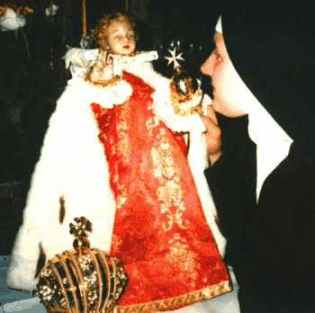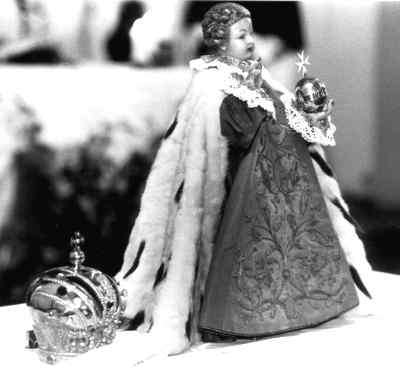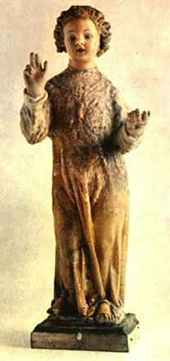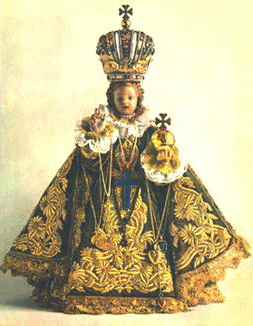



The Miraculous Infant Jesus of Prague
 |
 |
 |
 |
From [Miraculous
Images of Our Lord], by Joan Carroll Cruz,
The childhood of Jesus is an active devotion in the Catholic church for nearly a thousand years. Christians always longed to show their deep reverence to the incarnate God, Jesus Christ. This veneration was stimulated aside from the Gospel also by apocryphal writings like f. i. James's and Thomas's pseudo gospels. The Child Jesus was adored by Church Fathers like St. Athanasius or St. Jerome. Other great worshipers of the Childhood Jesus's are St. Bernard of Chlairvaux, St. Francis of Assisi and St. Anthony of Padua. During the Baroque space it was first of all St. Teresa of Avila, who always traveled with her sculpture of the Infant Jesus during founding new convents. In Spain this cult had great devotion. Individual depictions of the
Child Jesus had their beginning in the 14th century. The oldest sculpture can
be found in Germany where representative image had started in the visionary environment
of women's convents. Usually the Child Jesus is holding in his hands various
objects. With the right he mostly blessed, in the left hand he either holds a
bird, an apple, a book, a cross or bunch of grapes, which is a reference to the
Eucharisty. (J 15,1-11) In the middle Ages the sculptures were made of wood,
where as in the baroque period they are of different materials like wax, ivory,
bronze and others. In the baroque workshops, it became a habit to dress the statues. In the year 1631 the Saxons invaded Prague and the plundering did not bypass the monastery. The sculpture of the Child Jesus was thrown out with the waste behind the High Altar. Here Father Cyril a Matre Dei found it when he returned to the abandoned church in Mala Strana from München. The sculpture was damaged. After many attempts in vain, Father Cyril was happy to get some money from a Prague citizen for repairing the broken arms. The Infant Jesus thus became again the object of worship and a number of miracles were linked to the statue and also the protection of Prague from the Swedes. The family Martinic greatly worshiped the Infant Jesus. In 1651, under their leadership the sculpture was taken in procession from the church of Our Lady Victorious to all the churches in Prague. At this festivity it received the title Gratious. In 1655 the bishop of Prague crowned the Infant Jesus with a crown, that was ordered by Bernard Ignac of Martinic. In memory of this coronation a festive Mass is celebrated on the feast of the Ascention every year. At first the Infant Jesus was placed in the chapel of the Holy Rood. In 1741 because of the great number of pilgrims, it was transfered to the side altar of St. Joachim and St. Anne, opposite the miraculous picture of the Virgin Mary of Mantua. The Altar in its construction shows two lines. The vertical line goes from the Holy Ghoste via God the Father to the Child Jesus. The other - horizontal line passes from the Virgin Mary over the Child Jesus to St. Joseph. These represent the two levels of the human and the divine family. At that time small silver pieces like links were placed around as signs of thanksgiving. This peaceful time did not last long. After the death of the Empress Mary Theresa, her son Joseph II. followed her on the throne in Austria. He abolished the Carmelite monastery on July 3rd 1784. The church became a parish, that was administred by the Maltese Knights. In the 19th century the fame
of the miraculous Infant Jesus spread to the Spanish speaking countries of South
America and Italy. And not only there! In some monastries they used a special
liturgical prayer to the Infant Jesus of Prague. Many far away Asiatic countries
are thanking the Infant Jesus for miracles, like the Philippines, China or Vietnam. There are also legends narrated of the Infant Jesus of Prague. Can we possibly doubt their truthfulness, as they surely expressed how the people talked, lived and felt about the Infant Jesus? One of them is about the origin of the Infant . . . at the time of the battles, to occupy the Pyrenees Penicula, between the Maurs and the Christians there apparently was in the South of Spain a Carmelite Monastery. Even that monastery was invaded. Only four monks rescued their lives. One was called Joseph, who had a special devotion to the Child Jesus. Once as he worked in the yard, suddenly a little child appeared to him and asked to pray with him. Therefore the brother prayed the "AVE" and at the words "blessed is the fruit of your womb Jesus", the child said "that is me". Then the child disappeared, but its face was engraved in his memory. The brother longed immensly to see the child again, even for an instance. He wanted to produce a likeness, that would remind him of the Child Jesus, but his efforts were without success. For many years he struggled but could not make a portrait, until one day the child appeared again. At that time he was already very old. "I came to show my self again to you, so that you could finish the sculpture according to my likeness", said the child. Immediately he started to work. He finished the face like in a dream. He was happy! When he finished the work, the child vanished. The brother was very tired. He fell asleep and never woke up again. His little friend had come to take him home. As to whether this legend is historically true, I do not know. It sertainly shows however, a lot of feeling, and it is beautiful. Further 3 legendary narratives are caught up in three paintings of a series of pictures of the Gracious Infant, that originated in the first half of the 18th century. They tell of the time, when the sculpture was found with broken arms in the waste in the church behind the High Altar. Father Cyril was beggining for money to repair the sculpture of the Child Jesus, but without result. By chance a rich man Mr. Benedict Manskonig from Ústi, on the river Elbe, came to Prague. He fell seriousely ill and received the Last Rights from Father Cyril, who told him about power that the Child Jesus has. Mr. Benedict then gave 100 golden pieces to the Infant Jesus, to win the favour of the Gracious Child, and he recovered. Another tale describes, how father Cyril is praying to get money for new arms for the sculpture of the Infant Jesus, when a rich lady comes to visit him, to donate a big amount of money. A further story tells how the Gracious Child helped the rich family of Henry Kolovrat of Libstejn. His wife lost her hearing and eye-sight. When she was touched with the Infant Jesus, she was restored to health. The lady, however was very selfish. She kept the Miraculous sculpture in her palace as a protection. But when she wanted to leave the palace, the horses would not move. The lady then rearlized that she must return the Infant Jesus to where it belongs. After that they could leave the palace easily. The miraculous Infant Jesus was greatly worshiped by the mighty and the simple, poor people. Also it is of interest, that the first imitations of the Infant Jesus of Prague were created by the sculptor Jan Schlansovsky in the 18th century. He also carved a mould by which hundreds of copies were made, which were sent throughout the whole world.
Another case is the healing of an Indian woman, who had an accident in her youth, that paralyzed her. For a long time she had to rest in bed without moving. Once in a dream she saw the Infant Jesus and she understood, that she can be healed. She prayed the novena to the Infant Jesus, that someone ordered for her. While praying she started to observe that gradually the feeling come back to her feet and to her whole body. After a few weeks she was healed. In about 1994 she arrived here from USA as a 70-year-old grandmother with her husband and grandchild. All her life she had saved money for this trip to give thanksgiving to the Miraculous Infant Jesus of Prague.
Visit the Church of the Monastery of the Infant Jesus of Prague. Visit the [website]. The address is: Infant of Prague, Karmelitska 9, 11800 Prague 1, Czech Republic, EU.
|